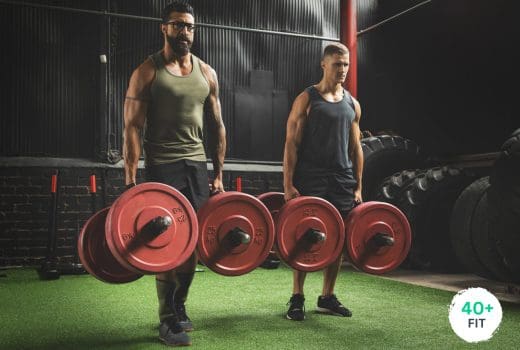Why Strong Forearms Matter After 40

Let’s face it, as we hit our forties, things start to change. We might notice a little less zip when climbing the stairs, and that once-iron grip might not feel quite as strong. But here’s the good news: stronger forearms can make a big difference in your everyday life, well beyond just arm wrestling your grandkids (although that’s definitely a perk!).
Think about all those daily tasks that rely on a good grip. From carrying groceries and opening stubborn jars to maintaining good posture while gardening or playing with the dog, strong forearms come in handy. Having a firm grip also helps prevent injuries during exercise or even unexpected falls. Stronger forearms provide better control and stability, which can keep you safe and active as you age.
Firing Up Your Forearms: Effective Dumbbell Exercises

Ready to sculpt those forearms and rev up your grip strength? Don’t underestimate the power of dumbbells! These versatile weights offer a fantastic way to target your forearms from the comfort of your home or gym. Here are three dynamic dumbbell exercises you can incorporate into your routine, along with variations to hit different forearm muscles:
Hammer Curls (Overall Forearm Strength)

Hammer curls are a fantastic all-rounder as it is primarily a bicep exercise but it also engages all the major muscle groups in your forearms. Here’s how to master the move with perfect form:
- Grab a dumbbell in each hand, palms facing your body. Stand tall with your feet shoulder-width apart and a slight bend in your knees for stability.
- Keep your elbows tucked in by your sides throughout the exercise. Now, curl the weights up towards your shoulders, focusing on squeezing your forearms as you lift. Imagine crushing a can between your bicep and forearm for that peak contraction.
- Hold for a second at the top to really engage the muscles, then slowly lower the weights back down to the starting position. Remember, control is key! Aim for smooth, controlled movements throughout the entire exercise.
Wrist Curls (Wrist Flexion/Extension)

Wrist curls come in two variations, each targeting specific forearm muscles. Here’s how to perform both for well-rounded development:
Palms-Up Wrist Curls (Flexion):
- Sit or stand with a dumbbell in each hand, palms facing the ceiling. Rest your forearms on your thighs or knees for stability.
- Slowly curl your wrists upwards, raising the dumbbells as high as possible. Squeeze your forearms at the top to maximize the effect.
- Lower the weights back down in a controlled motion, feeling the stretch in your forearms as you return to the starting position.
Palms-Down Wrist Curls (Extension):
- Flip your grip so your palms are facing the floor, holding the dumbbells with the same weight. Maintain that stable forearm position on your thighs or knees.
- With control, lower your wrists down as far as comfortably possible. You should feel a stretch in the underside of your forearms.
- Curl your wrists back up, squeezing the muscles as you lift the weights. Don’t forget to control the movement on the way back up!
Farmer’s Walks (Grip Strength & Endurance)

This exercise is a true test of grip strength and endurance! Here’s how to tackle it safely and effectively:
- Grab two dumbbells with a weight that challenges you, but allows you to maintain good form. Stand tall with your core engaged and shoulders back for proper posture.
- Let your arms hang naturally by your sides, palms facing your thighs.
- Take a step forward and begin walking, maintaining good posture throughout. Keep the weights down by your sides and focus on squeezing the dumbbells firmly throughout the walk. Engage your core to help stabilize your body.
- Walk for a set time or distance, pushing yourself but not compromising form. Once done, carefully put the dumbbells down and rest.
The Right Weight for You: Choosing Dumbbells Wisely (Focus on accessibility)
The beauty of dumbbell exercises lies in their adaptability. Unlike fixed-weight machines at the gym, dumbbells allow you to personalize the challenge to your fitness level. No need to invest in a whole rack of weights – you can start with lighter dumbbells and gradually increase the intensity as your strength improves. This helps prevent injuries and ensures you’re maximizing your workout results.
But how do you choose the right weight for you?
A good rule of thumb is to pick dumbbells that allow you to complete 10-12 repetitions of each exercise with good form. If you can breeze through 15 reps without feeling challenged, it’s time to bump up the weight a bit.
Remember, progress is key! Don’t be discouraged if you can’t lift the heaviest weights right away. Start with manageable weights and gradually increase the challenge as you get stronger.
Here’s a tip for added convenience: consider investing in adjustable dumbbells. These clever inventions allow you to easily change the weight by adding or removing plates. This way, you get a whole set of weights in one compact and affordable package, perfect for a space-saving home gym or for those who like to keep their workout options flexible.
Forearm Fitness After 40: Beyond the Exercises
Building strong forearms is about more than just cranking out reps. Here are some additional tips to maximize your results and prevent injury:
Master the Move: Focus on Form and Mind-Muscle Connection
Technique is key! Using proper form ensures you’re targeting the right muscles and reduces the risk of injury. Don’t be afraid to start with lighter weights if it helps you maintain good form throughout the exercise. Remember, it’s quality over quantity.
Focus on feeling the muscles you’re working. As you curl the weights, imagine crushing that imaginary can in your forearms. This mind-muscle connection helps you engage the targeted muscles more effectively.
Consistency is King (or Queen!)
Building strength takes time and dedication. Aim to incorporate your forearm exercises into your workout routine 2-3 times a week for optimal results. Consistency is key to seeing and feeling the difference in your grip strength and overall forearm definition.
Don’t Forget the Rest
Just like any other muscle group, your forearms need time to recover and rebuild after a workout. Schedule rest days in between your forearm training sessions. During this time, your muscles repair microtears and grow stronger. Listen to your body – if you experience pain, take a break and resume your workouts when you feel ready.
Warm Up and Cool Down: Prepare for Success
Always warm up your forearms before starting your workout. A few minutes of light cardio like jumping jacks or arm circles gets your blood flowing and prepares your muscles for exertion. After your workout, take some time to cool down with static stretches to improve flexibility and prevent soreness.
Feeling the Forearm Fun? Take it Further!
Conquered these exercises and craving a bigger challenge? No problem! Here are ways to push your forearm workouts to the next level:
Up the Weight: As your strength increases, so can the weight you lift. Gradually increase the weight of your dumbbells while maintaining proper form. This will force your muscles to adapt and grow even stronger.
Challenge Yourself with Supersets/Dropsets: Supersets involve performing two exercises back-to-back with minimal rest. This keeps your heart rate up and intensifies the workout. Dropsets involve reducing the weight of your dumbbells mid-set, allowing you to squeeze out more reps until exhaustion. Both techniques can be a great way to challenge your forearms and accelerate progress.
More Reps, More Sets: Ready to test your endurance? Increase the number of repetitions or sets you perform for each exercise. Aim for 12-15 reps per set for increased endurance, or try performing 4-5 sets instead of 3 for a more intense workout. Remember to listen to your body and adjust the intensity as needed.
Strong forearms are more than just impressive handshake material. They contribute to everyday activities, injury prevention, and overall fitness.
So, grab those dumbbells and get ready to sculpt those forearms! Remember, consistency and proper form are key. With dedication and these tips, you’ll be well on your way to achieving a stronger, more confident you.






